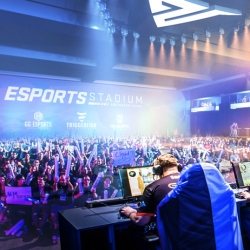
The Esports Arena Arlington will have adjustable crowd sizes and 7-days-a-week stationary gaming for visitors.
An architecture firm and an electronic sports venue developer want to bring the world’s largest eSports stadium to Arlington, Texas. Arlington is home of the Dallas Cowboys and Texas Rangers, so the city which is located between Dallas and Fort Worth has a reputation for stadium building.
Everything is bigger in Texas, which seems to be the theme for Esports Arena Arlington (EAS), a $10 million stadium which will be dedicated to e-sports only. The biggest esports stadium in the U.S. will be roughly 100,000 square feet and can hold 1,000 spectators.
When completed, the arena should draw world class eSports events to the DFW Metroplex.
While in the past, experienced professional gaming has been enjoyed via streaming platforms, such as Azubu, Twitch and Ustream, live arenas have quickly begun to take over. In 2017, Bird’s Nest sports stadium, a stadium built for the Olympics, held the championships for League of Legends. Close to 40,000 gaming fans came to watch.
Bringing eSports to Arlington, Texas
Esports has grown over the years and is expected to become a $2.3 billion industry by the year 2022. The plans for the new Arena were put together by the City of Arlington, Esports Venues and the architecture studio, Populous. The Esports gaming arena will not have the same feel as your typical sports stadium though.
Brian Mirakian, who has led the ongoing project at Populous, discussed the reasoning behind the layout of the new stadium. Mirakian said, “There’s a lot of similarities that eSports share with traditional sports. Fans want to go and be together to share an experience. That’s the universal aspect that’s the same.”
“But where there’s a lot of difference is, a lot of times, [eSports] events are very much longer. They don’t have a finite beginning and end.”
How eSports Differs from Sports
Your average sports game has some sort of expected time frame. With the exception of the being the extra innings that sometimes occur during a baseball game, most games usually last no longer than 4 hours.
This is not the case when it comes to the tournament play of an esports competition. Electronic sports tournaments can last 8 to 10 hours, making it a full day, or even weekend, affair.
Because of this, many of the structural and interior designs of your normal sports stadiums do not work for an esports arena. Instead of typical concrete ramps, metal seating, and hotdog-and-beer vendors, the new eSports concourse will give the look and feel of something closer to a high-end sports bar. The bar area will be stocked with plenty of areas to relax and lounge. The dining area will have tasty light cuisine, as well as places to compete in a match yourself.
“Something for Everyone”
Brian Mirakian said, “It’s important to create these common social spaces that have something for everyone. Public gaming areas. Access to food and beverage. Sponsor activations. Meet and greets with the team. Smaller-scale competition. We think that’s just as important as a large-scale venue itself.”
The arena’s social spaces will be open to the public seven days a week. For that reason, the venue needs to be designed for a different style of entertaining. The venue needs to be set up for long-term public use. The stadium’s planners estimate that students from the nearby University of Texas will be frequent visitors to the stadium, both to enjoy events but also to hang out when no events are taking place.
Public Video Game Arena
The main arena stage is laid out to support stationary games, where players will compete on their own computers. There’s a stage for the players in the tournament, seats for fans, and screens to watch the action all throughout the stadium.
Another feature you would not see in a typical sports stadium is that the new venue will be “adjustable”. Panels throughout the venue will allow the main theater to either grow or shrink, adjusting to the size of the competition. This allows smaller eSports competitions to never be empty like a large stadium might, if the venue did not sell out tickets for the event.
Mirakian said, “From our perspective, one of the most important parts of designing a space for esports today is that you have multiple games being played, and multiple spectator sizes. So being able to have a large-scale space that’s flexible for different sizes is critical.”
Broader-Scale Development Strategy
The Populous founder said, “The direction of all entertainment venues going forward is, the path of any stadium type is part of a broader-scale development strategy, where the stadium has 365-day life and usage. We want to plant a flag in the ground about the future of these venues.”
Esports has grown so rapidily in such a short time span that the Arlington eSports Venue might be obsolete in a few short years. If the sport continues to grow, the world’s largest eSports stadium might be nothing compared to venues that will go up 10 to 20 years down the line. For now, Brian Mirakian believes that this venue will set a standard for what the future can expect to look like with esports gaming.
